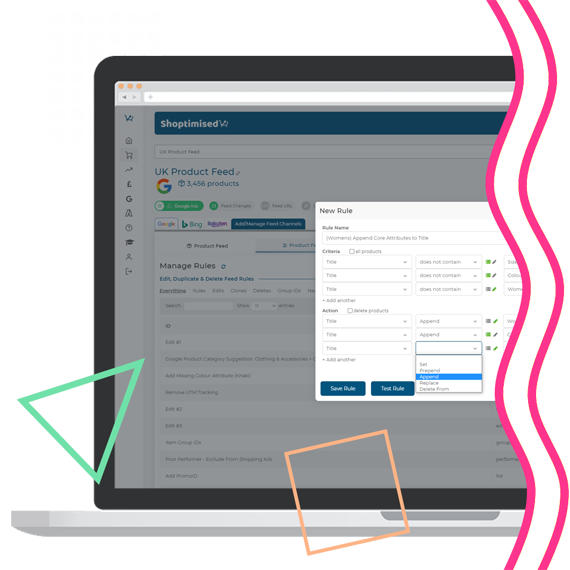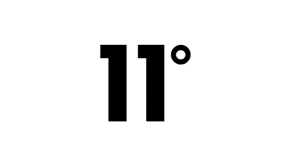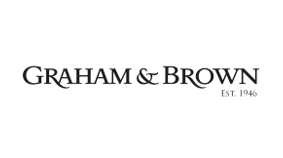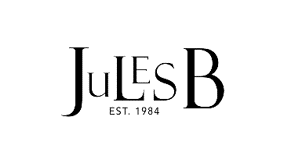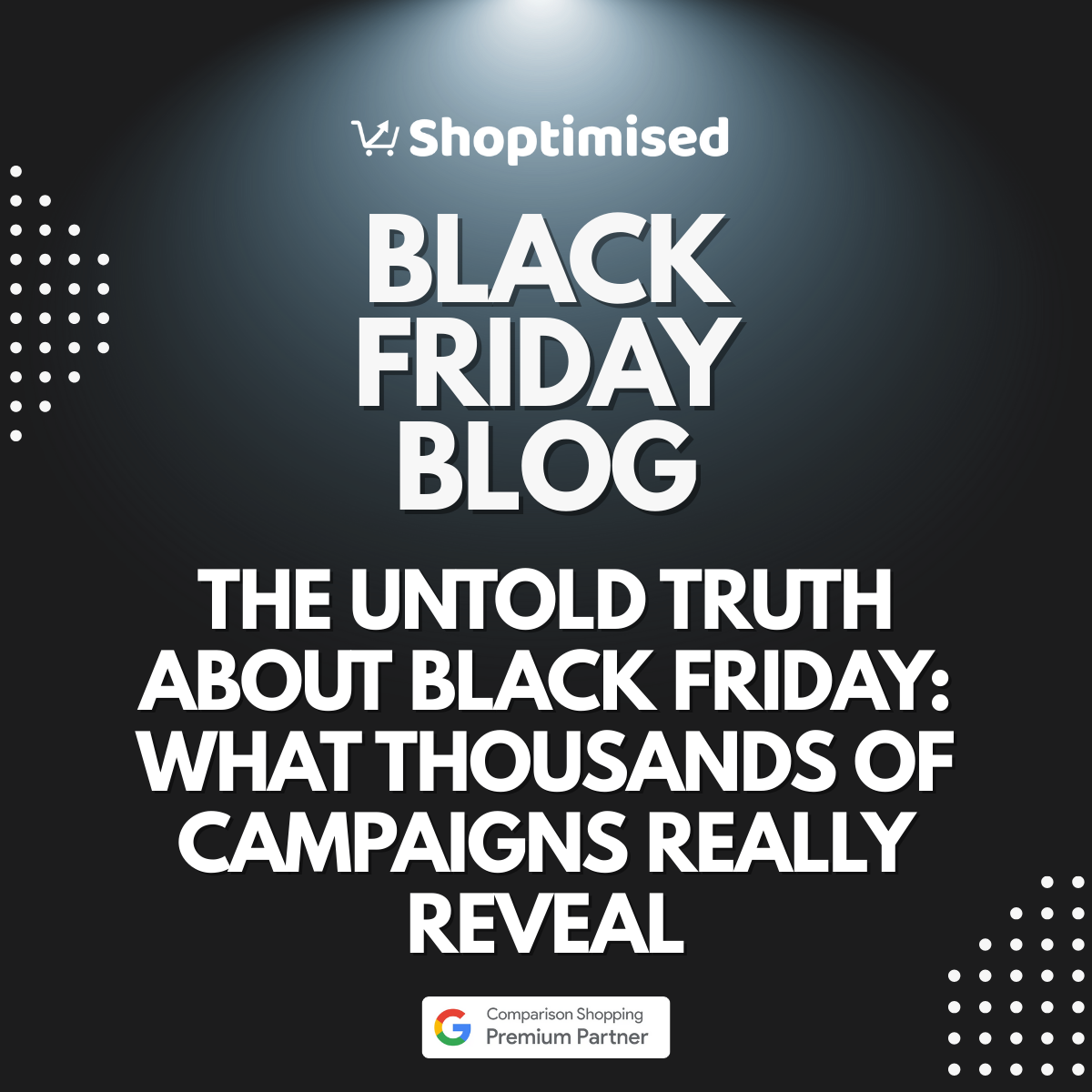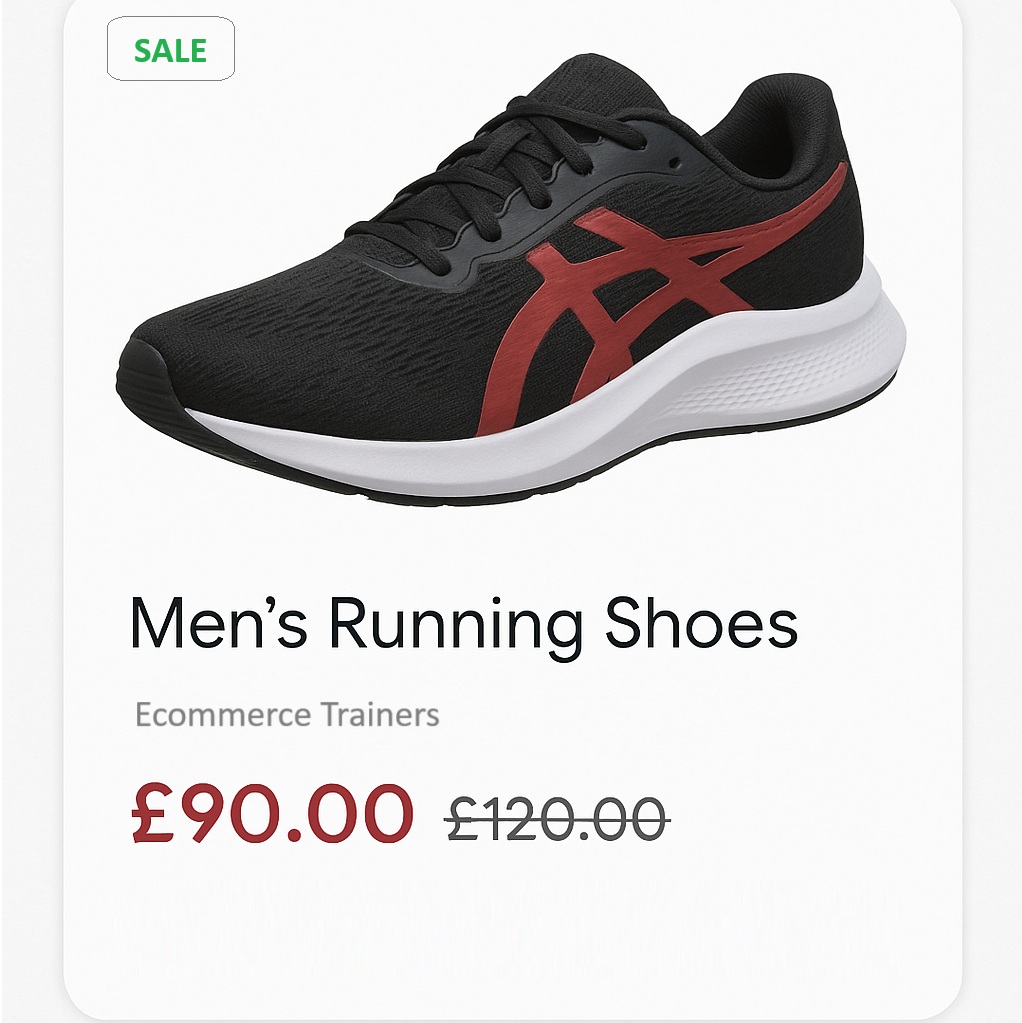What is Product Feed Optimisation?
The quality of your Product Feed has a major impact on your Shopping campaign performance and it’s responsible for every search term that your Shopping Ads appear for. Through the practise of Product Feed Optimisation, you can improve your reach such as clicks and impressions as well as improving your Return on Ad Spend while increasing your overall revenue.
Approximately 80% of all the search terms your Shopping Ads appear for are matched to words and phrases within your Product Titles. Ensuring Product Titles are well optimised, well structured and make use of the 150-character limit is essential. But whilst Product Title optimisation is a key element to Feed Optimisation, to maximise the potential of your Shopping Campaigns, there is so much more that you can do.
Leading PPC agencies and online retailers are widely adopting Product Feed Optimisation as a major focus of their ongoing online marketing strategies. Continue to read our Product Feed Optimisation guide to discover where to start and just how important it is to your Shopping Campaign performance.
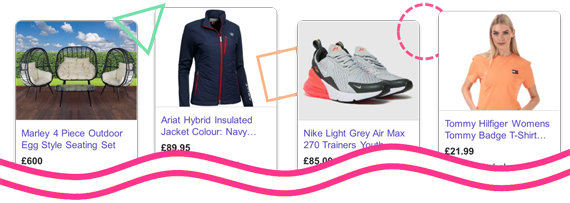
"Your Product Feeds are responsible for 100% of the search terms your Shopping Ads appear for
If you're not in control of your Product Feeds, you're not in full control of your Shopping Ads."
How Can Our Product Feed Optimisation Software Help You?
Our Product Feed Optimisation software is designed to give you full control over your Product Feeds. You will not need to wait for help from Developers or third parties. Use our powerful rule engine to optimise thousands of products in minutes and fix seemingly difficult issues in seconds.
Our simple interface, powerful rules and insightful Auto Suggestion tool ensures that users of all levels can use Shoptimised to improve and and grow their online Shopping sales.
Our Users
Free Product Feed Audit
Free Product Feed Audit
Use our free audit tool and find out how well-optimised you Product Feed is within 30 seconds.
Our Product Feed audit will benchmark your Feed against industry benchmarks and best practise levels.
We'll also highlight the areas of improvement by Product Titles, Descriptions, Attributes, Google Categories, Images and more.
PRICING
Enterprise Software, Entry Level Prices
Compare our subscription levels and choose your fit.
In-House
Monthly Subscription
- 10 User Logins
- 3 Optimised Output Feeds
- Max 100,000 Products per Feed
- Feed Output Channel: All
- Also Includes:
- Product Edits
- Optimisation Rules
- Performance Rules
- Automated Audits
- Auto Suggestions
- Premium Google CSS
Small
Monthly Subscription
- 20 User Logins
- 10 Optimised Output Feeds
- Max 100,000 Products per Feed
- Feed Output Channel: All
- Also Includes:
- Product Edits
- Optimisation Rules
- Performance Rules
- Automated Audits
- Auto Suggestions
- Premium Google CSS
Medium
Monthly Subscription
- 40 User Logins
- 30 Optimised Output Feeds
- Max 100,000 Products per Feed
- Feed Output Channel: All
- Also Includes:
- Product Edits
- Optimisation Rules
- Performance Rules
- Automated Audits
- Auto Suggestions
- Premium Google CSS
We partner and connect with every major Search Engine, Social and Affiliate Network.



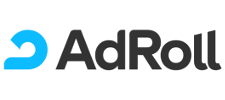






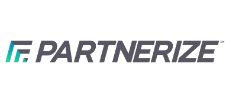
Product Feed Optimisation Guide
Product Titles
Approximately 80% of all Search Terms that your Shopping Ads appear for are matched to words and phrases within your Product Title.
Product Feed Optimisation is hugely important for creating and managing successful Google Shopping Campaigns. Product Titles alone are one of the most important factors in whether Google considers your product to be relevant to the user’s search term.
Far too often, it’s said that PPC Managers can only control Shopping Search Terms by adding negatives. This isn’t true – you can control them by optimising your Product Titles. 99% of Product Feeds will pull the title from your websites meta title or H1, so it’s important to make sure you can change the title in your Product Feed without impacting your website. If you don’t have the ability to change one without the other, then make sure you consider the impact on your SEO and where your products rank organically.
Optimising your Product Titles can increase your impressions and reach within Google Shopping, which can ultimately increase your shopping impressions, conversions, and revenues.
Word order is critical! Make sure you front-load your most important information to the beginning of your product titles. Google weighs the importance of the words within your Product Titles from left to right. For instance, ‘Womens Nike Air Max 720 Trainers, Size 5 in Black’ would capture more relevant traffic for a woman’s trainer than ‘Nike Air Max 720 Shoes, Black, Size 5’.
You can also optimise your Product Titles to narrow your reach and focus directly on lower volume and higher converting search terms. The point being, that by optimising Product Titles, you have much more control.
Analyse your Search Term reports to discover which search terms and words feature more prominently within your converting search terms.
Product Title Best Practises:
- Avoid vague titles. Make sure it’s clear what the product is to improve search relevance. Utilise available characters.
- Include relevant attributes that are important to a user searching for that product (ex. Brand, Colour, Material, Size, etc). Improves offer quality and the likelihood of showing for relevant searches.
- Front-load important attributes in the title. The number of characters that show will depend on the ad unit being shown and, in most cases, 70 or fewer characters will be displayed in Google Shopping dependent upon your device or screen size, but Google will read up to 150 characters within your Product Titles
But there is far more to Product Feed Optimisation than just optimising your Product Titles. The quality of your data and the way that your data is organised is also a hugely important factor for your success.
For a full list or Product Title specifications, click here.
Product Types
Product Types play a more important rule in your Google Shopping performance than most realise and they have two core benefits:
1 – You can use them to create your own campaign structure
2 – Google match approximately 5% of search terms to the information within your Product Types
Most Product Types that are automatically generated within a Product Feed marry the websites navigation structure, such as
Home > Mens > Trainers > Nike
However, this means that quite often the first level might state Home or Sale which are not relevant to the product itself. Also, Google considers any promotional phrases or overuse of keywords in Product Types as a violation of their spamming policy.
Google also recommends that your Product Types should have a minimum depth of 3, such as
Mens > Trainers > Nike
We see better results where the Product Type has a minimum depth of 5 as this helps with the matching of more relevant Search Terms and also enables you to be more granular in your Campaign structure.
What To Avoid
Many Product Feeds utilise the website navigation, this can lead to the first or addtional levels, containing things Home or Clearance which is not relevant to the product.
Wrong: Home > Adidas
Also, make sure that you do not contain promotional sections within your Product Types or violate the Product Type policy by spamming Product Types.
Promotional: mens > trainers > sale > 40% off section
Spam: mens trainers > cheap trainers > cheap Adidas trainers > black trainers> Adidas Originals on sale
Where To Focus
There are 2 very powerful benefits to having a Product Depth of 5 or more.
Provides Google with critical information to match products to user searches terms.
Produce a good structure for Shopping campaigns
Right: Trainers > Adidas > Mens > Black > Originals > Size 9:
Product Descriptions
Approximately 15% of all the Search Terms your Shopping Ads are shown for are matched to words and phrases within your Product Descriptions.
The Product Description attribute is required for all products. Products that do not include a Product Description will still be eligible to serve in Google Shopping results, however, they will receive limited Impressions and similar products that do include a
The Product Description attribute is required for all products. Products that do not include a Product Description will still be eligible to serve in Google Shopping results, however, they will receive limited Impressions and similar products that do include a product description will be prioritised above those missing the Product Description attribute.
Google recommends having a minimum of 3,000 characters to a maximum of 5,000 characters within your Product Descriptions. However, in our experience, this just increases the volume of Negative Keywords that you’re forced to build. Instead, we recommend a minimum of 500 characters to a maximum of 1,500. Increasing the character count in your Product Descriptions with relevant Search Terms and Product Attributes to our recommend limit increases your impressions on average by 30%.
Make sure you avoid using any promotional test, repetitive content, and delivery information within your Product Descriptions. Also avoid using special characters, emojis, and too much capitalisation.
By default, Google crops your Product Descriptions and shows a ‘More’ function. After your first well wrote and descriptive paragraph, try to include more relevant product attributes and converting search terms.
This is a poor example from Ralph Lauren and they are wasting the opportunity to gain more relevant search terms within their Product Description.
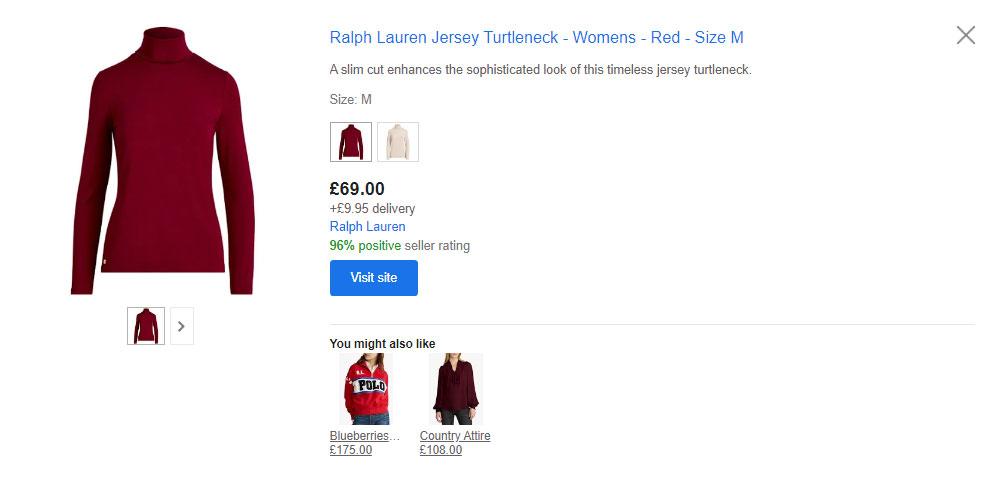
This example from House of Fraser, whilst not well written, is optimised for Google Shopping Search Terms. Selecting the ‘More’ option reveals that they have also opted to include their in-depth Product Type attributes into their Product Description.
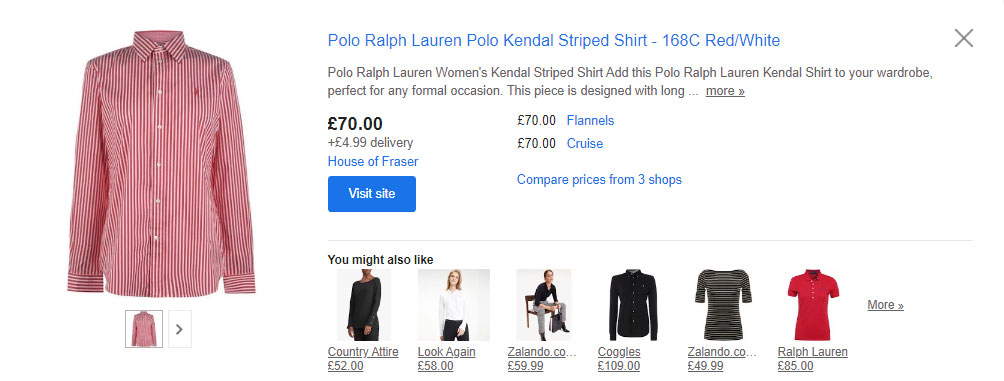
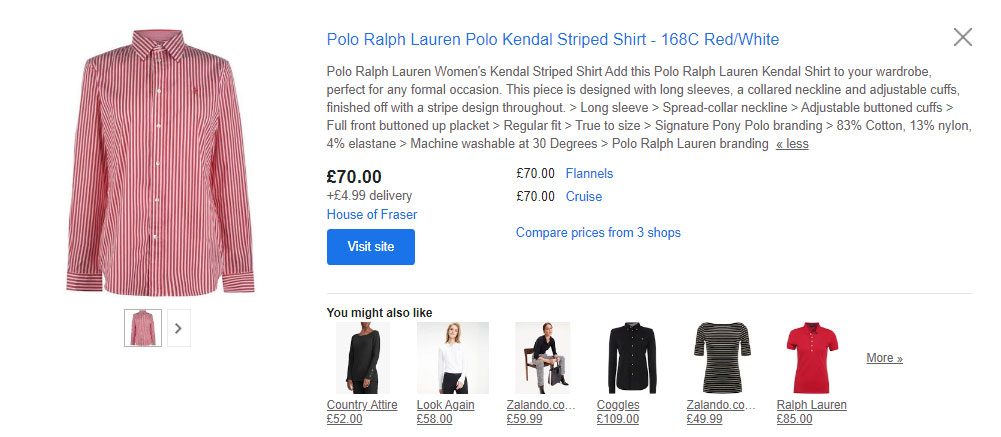
This example from Xile Clothing is well written but it doesn’t include any product specific attributes such as Colour, Size or Size Type. It does mention cotton as the material and menswear, but not men’s specifically.
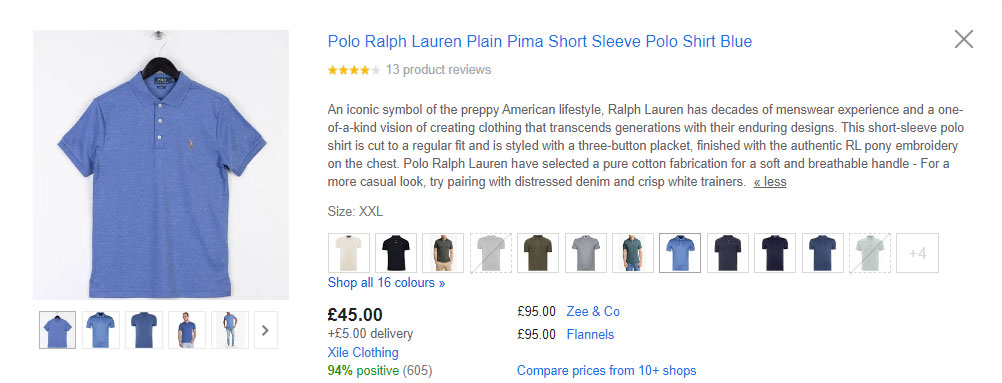
We would recommend that this product be optimised to show the following:
Current Title: Polo Ralph Lauren Plain Pima Short Sleeve Polo Shirt Blue
Optimised Title: Mens Polo Ralph Lauren Plain Pima Short Sleeve Polo Shirt in Blue, Size XXL
Current Description:
An iconic symbol of the preppy American lifestyle, Ralph Lauren has decades of menswear experience and a one-of-a-kind vision of creating clothing that transcends generations with their enduring designs. This short-sleeve polo shirt is cut to a regular fit and is styled with a three-button placket, finished with the authentic RL pony embroidery on the chest. Polo Ralph Lauren have selected a pure cotton fabrication for a soft and breathable handle – For a more casual look, try pairing with distressed denim and crisp white trainers.
Optimised Description:
The Men’s Polo Ralph Lauren Plain Pima Short Sleeve Polo Shirt in Blue, Size XXL is an iconic symbol of the preppy American lifestyle. Our men’s blue Ralph Lauren short-sleeve polo shirt in XXL is cut to a regular fit and is styled with a three-button placket, finished with the authentic RL pony embroidery on the chest. Polo Ralph Lauren have selected a pure cotton fabrication for a soft and breathable handle for this men’s blue Polo Shirt.
An iconic symbol of the preppy American lifestyle, Ralph Lauren has decades of menswear experience and a one-of-a-kind vision of creating clothing that transcends generations with their enduring designs.
Department: Men’s, Ralph Lauren, Polo Shirt, Short Sleeved, Blue, Cotton, Size: XXL
Remove Merchandising Content from Product Descriptions
“For a more casual look, try pairing with distressed denim and crisp white trainers.”
Whilst merchandising content is great way to cross sell your products within your website, when including it within your product feed you increase the risk of your Polo Shirt being shown for Denim or trainer related search terms.
Product Images
Your Product Images are going to be front and centre in your Shopping Ads so make sure your images are of good quality, especially when considering how much traffic comes from mobile devices. Don’t include text over your images or watermarks which make the image unclear as Google will also disapprove these products. Make sure that your product variants all have the correct picture and do not just use the parent picture for each variant.
100×100 is the minimum resolution allowed across all verticals, except apparel where the minimum is 250×250. You cannot submit an image larger than 64 Megapixels are an image file larger than 16 MB.
Images with an 800×800 resolution can lead to higher impressions/clicks due to their higher quality score.
Also, make sure that you’re not blocking Google from crawling your images within your robots.txt file.
When you submit a product to Google via your Product Feed, Google will index and cache your images to they can serve them quicker in the future. It takes Google 48 to 72 hours to complete their indexing of your images. If you add a new Primary Product Image into your feed, that can cause your product to stop showing in Shopping results until it is indexed. We, therefore, recommend that you add the new image as an Alterative Product Image until it is indexed at which point you can then change that to the Primary Image.
If you update the image to the same image path, Google will not change the image as they will not recognise that this has changed. This is important when selling products where the look pf the product may change but not the actual product, such as a magazine.
Whilst you cannot use a generic image, graphic, or illustration, there are exceptions to this rule for products within the following Google Product Categories: Hardware (632), Vehicles & Parts (888) and Software > Computer Software (313)
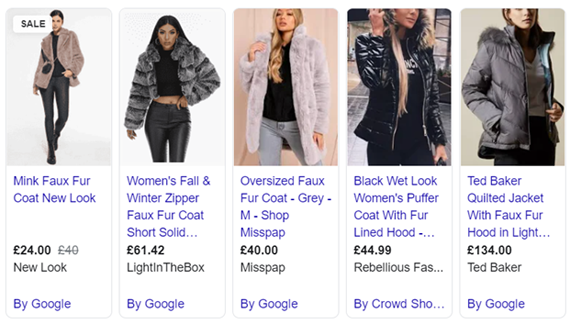
Google Product Categories
Google Product Categories inform Google which auctions they should be serving your products in whilst helping them to understand what your products are.
Our recent testing shows that Product Feeds with no Google Product Categories have a 27% higher Cost per Click than Product Feed with Google Product Categories when utilising Google Smart Shopping campaigns.
There are many options within the Google Product Taxonomy to choose from, but you should always aim to select the most granular and relevant category that best suits your products. Being as specific as possible helps to reduce the irrelevant Search Terms that Shopping Ads appear for. Over time, this increases your Click-through Rate which helps to lower your Cost per Click and this will ultimately lead to an improved Return on Ad Spend.
Products that fall within certain Google product categories which include some sub-categories of Media and Clothing & Accessories will require additional attributes and/or a combination of unique product identifiers. If the additional attributes, such as Gender, Age Group, Size, and Color are not provided, your products will receive limited Impressions, and similar products that do include the correct attributes will be prioritised above those without.
GTINs (Global Trade Item Number)
GTINs of Global Trade Item Numbers are essentially the UAN or barcodes of your products. If your product has a GTIN, then it is essential that you include that within your Product Feed. Google understand which products should have GTINs based on the brand and Google Product Category. Whilst Google used to disapprove products that were missing the GTIN, they are now more lenient. However, products that should have a GTIN but do not include them in the feed will either be at worst disapproved or at best, restricted to limited impressions.
Product Attributes
Google has 8 standard product attributes that you should always include within your Product Feed where relevant. Utilising the correct Product Attributes improves the overall quality of your Product Feed, but it also improves the performance of your products within the Google Shopping Tab.
The Google Shopping utilised Product Attributes within their filtering. If you do not utilise the correct Product Attributes when a user filters your products will disappear from results. Whilst the Shopping Tab receives an overall smaller percentage of Shopping traffic than the Shopping Ads in the Google Search page, conversion rates in the Shopping Tab are higher. This is because visitors van filter products further to find the right products at the right price before entering the advertiser’s website to purchase.
Brand
The brand should be the brand of the product not the brand of the retailer. For instance, if you’re retailer names Ecommerce Superstore selling Nike trainers. Make sure the brand of the product is Nike and not Ecommerce Superstore unless you’re selling your own branded products.
Colour
If your product has a colour or multiple colours, ensure you list them within the Colour Attribute.
Products with more than one colour input will receive warnings within the Google Merchant Center. If your product is multi-coloured, you can still to specify more than one colour value using slashes and hyphens, but you may not separate values with commas.
Right: Red/Green/Brown
Wrong: Red, Green, Brown
Gender
If your product is Gender-specific, make sure you include this attribute. The gender attribute is a choice of the following options:
Male
Female
Unisex
Age Group
If your product is Age Group-specific, make sure you include this attribute. The Age Group attribute is a choice of the following options:
Newborn
Infant
Toddler
Kids
Adult
Material
You should include the material attribute if your product has a specific material such a leather, cotton, gold, plastic, steel etc. The material attribute isn’t just for clothing products.
Pattern
You should include the pattern attribute if your product is an important and distinguishing feature. You can also utilise the Pattern attribute where products include printed graphics. Here are some examples of when the pattern attributed should be used.
Title: Womens Polka Dot Dress Size 9
Pattern: Polka Dot
Title: Mens England Football World Cup 66 Printed Graphic T-Shirt, White, Large
Pattern: Graphic
Size
Use the Size attribute to describe the size of each product. Make sure you use a standard size format that is consistent. For instance, do not use a mix of L, Large and Lrg, use either L. You can still opt to use Large within the Product Title.
Whilst you can use One Size or OS, do not submit values such as N/A, none, or multi-size. If your product has no size attribute, leave the attribute blank.
Condense multiple size dimensions such as 16 Inch Neck and 34 Inch Sleeves to 16/34. If your product has other size dimensions such 8 Wide, condense to 8 W.
The size attribute is a requirement for products with the following Google Product Categories:
Clothing & Accessories > Clothing (1604)
Clothing & Accessories > Shoes (187)
To make sure you use the correct sizing within your Size attributes, refer to the size guide from Google.
Size Type
The Size Type attribute helps you to describe the cut of your product with 5 options to choose from:
Regular
Petite
Plus
Big and Tall
Maternity
Size System
The Size System attribute lets you define which countries size system you are using and you can select from the following list:
AU – Australia
BR – Brazil
CN – China
EU – Europe
FR – France
IT – Italy
JP – Japan
Mex – Mexico
UK – United Kingdom
GB – Great Britain
Cost of Goods Sold (COGs)
The Cost of Goods Sold or COGs attribute is intended to be used in conjunction with conversion tracking to improve your reporting to include Gross Profit. However, we also use this attribute to create unique Margin data within your Custom Labels so you can create Campaigns & Ad Groups based on the margin of your product. This enables a far more powerful and strategic campaign structure that ultimately lets you push more budget to products with a greater margin to maximise your Return on Ad Spend within your Google Shopping Campaigns.
The data within the Cost of Goods Sold attribute should be formatted in the same way your price data is, such as:
Price 15.99 GBP
COGs 4.99 GBP
Item Group IDs
Whilst a lot of ecommerce websites struggle to take advantage of Item Group IDs, they can have such a positive impact on your revenue when you do include them. You can group products together that differ by one or more of the following attributes:
- color [colour]
- size [size]
- pattern [pattern]
- material [material]
- age_group [age_group]
- gender [gender]
This will deliver those options directly within the Search Results. This further qualifies the intent of the user before they click into your website, which has the desired impact on your conversion rate and sales.
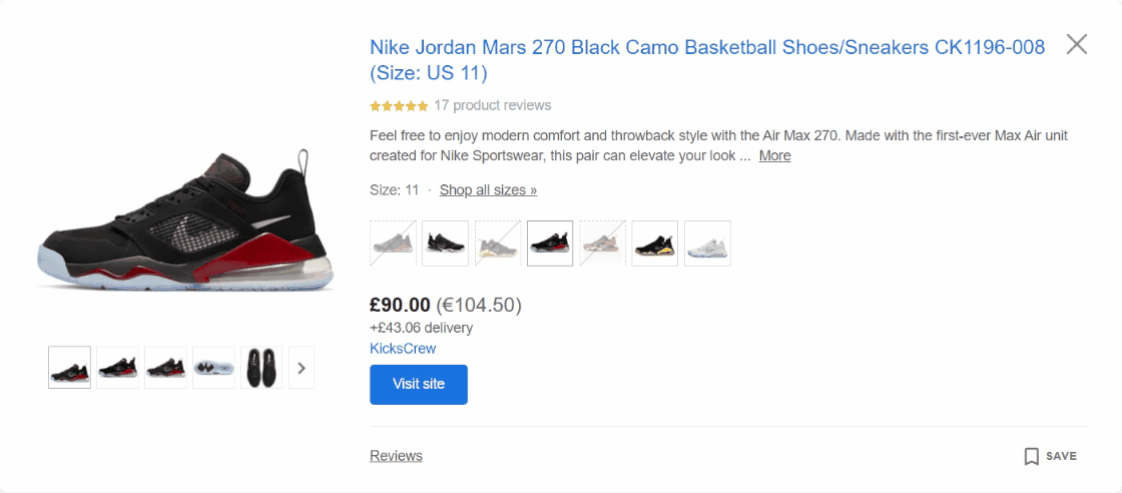
Adding Item Group ID’s can increase the position of your products within the Shopping Tab or the Google Shopping CSS Website as it is now known. This helps to improve the Click-through Rate and Conversion Rate of your products. It’s a simple change, but it can have a big impact on performance.
Custom Labels
OK, so Custom Labels don’t really enhance your feed in terms of you being found. But utilising Custom Labels can have such a profound impact on your ability to structure your Shopping Campaigns and get the most out of your performance. Here are a few of our top tips:
1 – New Products
You need to give new products a fair crack of the whip when it comes to Google Shopping campaigns. You will always have consistent performers and you’ll find the budget and clicks are skewed in their direction. Make sure you can split out your new products, so you can fully test whether they are going to become your next top sellers!
2 – Sale Items or Price Drops
Having the ability to split out sale items into their own Campaigns helps you to have great control over your budgets. Either limit or take advantage of these items by driving more traffic to products that will have bigger discounts.
3 – Top Sellers
Ensuring your top-selling products are always visible and have enough budget is essential to any Google Shopping effort and the ability to grow your sales further.
4 – Price Bands
Most retailers have a variety of price bands, and by creating price band custom labels such as £0.00 to £5.00 or £29.99 to £49.99 helps you to create an intelligent bid strategy that will ensure you don’t pay too much for clicks that will eat into your profits.
5 – Margin Bands
Like price bands, margin bands are an even better way to go, if you know the margin you have in each product. However, should you decide to have a sale, offer discounts or reduce your prices, you will need to make sure you update your custom labels to make sure your bidding strategy doesn’t start to hinder your performance.
Product Details
To help further improve your Product Feeds data quality, Google has created the Product Detail attribute. The Product Detail attribute can be used to provide technical specifications that are not already covered by existing attributes. This optional attribute lets you provide readable, structured data and enhances Google’s ability to surface individual products based on user queries.
Each Product Detail attribute has three sub-attributes. They are Section Name, Attribute Name and Attribute Value. The Section Name is only optional, but still recommended.
This attribute is going to help you win traffic and sales for highly qualitative search terms. So, whilst the traffic volume may be lower, the conversion rate should be higher. Do not duplicate data within the attribute or keyword stuff. Make sure the content you use is very specific details about the product.
Product Highlight
The Product Highlight attribute lets you add short sentences to showcase your product’s most important features and unique selling points. This attribute will help to increase the visibility of products using expert-related, product-specific terms that could help to increase long-tail search. Do not use generic search terms in these attributes.
You can have a maximum of 10 Product Highlight attributes with up to 150 characters per highlight. Google currently recommends 4 to 6. As of the time of writing, these attributes are new, and we have not completed a study on the best practices for them yet.
Sale Price Annotations
Google has relaxed the requirements for displaying Sale Price Annotations in Shopping ads. To show this annotation, the base price, or a higher price, must have been charged for a period of at least 30 days (reduced from 90 days) in the past 200 days. (Note: days do not need to be consecutive.) This will lead to more Sale Price annotations being utilised within Google Shopping Ads.
Take advantage of the Sale Price Annotation, make sure you continue to pass their RRP in the Price attribute and the sale price in the Sale Price attribute. Do not lower the price in the Price attribute. The discount on the sale price must also be greater than 5% and less than 90% to be eligible.
Promotion IDs
Utilising Promotion IDs is a great way to stand out within Google Shopping results during key trading times and within sale periods. Whilst many advertisers choose to blanket their promotion IDs, you will have greater control and a better bottom line by creating more granular promotions that you can apply on a brand, product or category level within your feed.
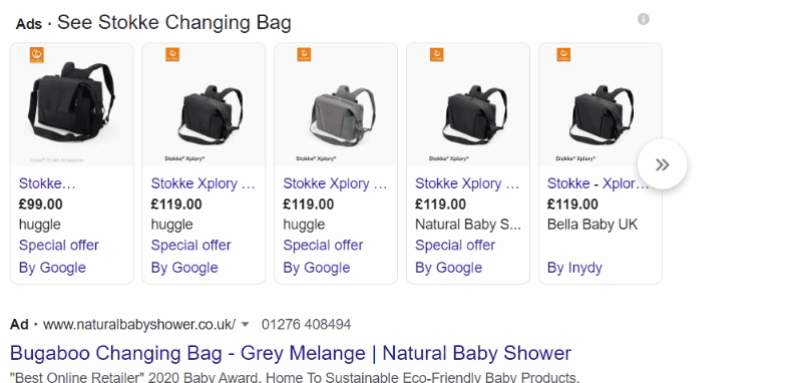
Google Merchant Center
Within your search campaigns, you can see a quality score for keywords, but Google Shopping campaigns, you don’t get a numerical score which you can simply improve within the Google Ads interface. This makes the Google Merchant Center incredibly important to the success of your Google Shopping campaigns.
Similar to search campaigns, historical data such as Clicks, Impressions, Click through Rate, Conversions, Revenue and ROAS are a big factor in the ongoing performance and quality score of your Google Shopping campaigns. This data is all held by the Merchant Center and assigned to the unique Product ID of your products.
It’s very important that you do not change the Product IDs of a product or this data will be lost, and a once good performing product will be reset and suffer a period of underperformance whilst the data builds back up.
It is important to consider your Product Feed when in the process of a website migration. A lot of consideration is given to the 301 Redirects during a website migration but most overlook the importance of maintaining the same Product IDs which is essential to continue the performance of the existing products.
The Merchant Center also informs you about, warnings, disapprovals and suspensions at a product, account and product feed level. There are many different types of warnings, disapprovals and suspensions, but you should always aim to correct these regardless of their state. Take your time to read the information provided by Google when addressing these actions, especially suspensions. Google can give you anywhere from 7 to 30 days to correct any issues which has prompted an account suspension. Before you ask Google to review your feed to have a suspension or suspension reviewed, make sure you have correctly addressed the issue. If you failed to do so and have requested that Google review, you will have to wait a further 5 working days before you’re able to request another review.
You can contact the Google Merchant Center help team online here.
Delivery & Shipping
You can add your Delivery & Shipping costs directly into your product feed or within the Shipping & Returns area of the Google Merchant Center. Any Delivery & Shipping information that you add into your Product Feed will take priority over the information you have in your Merchant Center.
Make sure the Delivery & Shipping information is accurate, on one hand you don’t want to disappoint customers by delivering slower than promised. However, having a long delivery time can adversely impact upon your conversion rate. So if you’re adding your delivery information into the Shipping & Returns section of the Merchant Center, make sure your collective handling and shipping times (which are added together to give the potential customer your total time) accurately reflect how quickly products can bought and received.
Google Shopping Ads & The Two Sides of Google Shopping
Google Shopping Ads
Your products appear in Google Shopping Ads when a user Search Term is matched to information within your Product Title and/or Product Description and/or Product Type. The position of your Shopping Ad is based on your bidding strategy, campaign structure and the quality score which is tied to your Google Merchant Center.
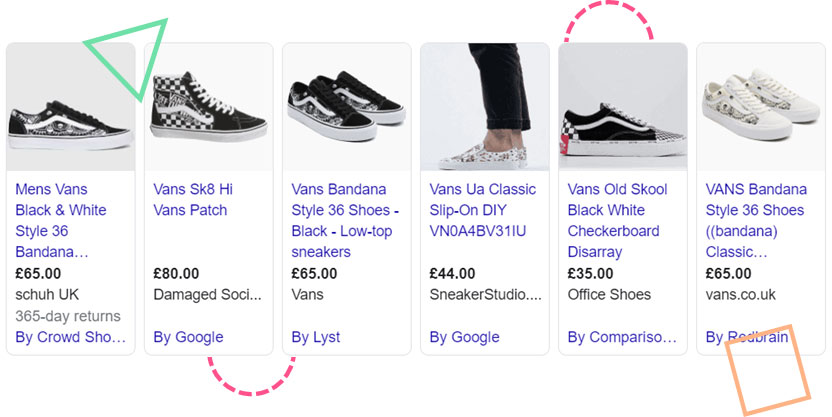
Google Shopping CSS Website
Believe it or not, Google Shopping like ourselves is a Google CSS Partner and the ‘Google Shopping Tab’ is their Google CSS Website. Whilst a much smaller percentage of Google Shopping traffic goes through their Shopping Portal and whilst the user’s initial search term is matched to information within your Product Title and/or Product Description and/or Product Type, your Product Feeds needs to be of a much higher standard to benefit from the traffic on this website.
In the USA, many of the product listings in the Google Shopping Tab are now free. This is expected to follow in the UK and Europe sometime later this year.
The first thing to understand about the Google Shopping CSS Website is that although there is less traffic, the eCommerce conversion rate of traffic sent from this site to your site is higher than standard Google Shopping Ads. The Cost per Click is also lower on the Google Shopping CSS Website than the Shopping Ads which ultimately results in a higher Return on Ad Spend from the traffic you can win here.
The Google Shopping CSS Website provides far better results and lets users filter these results to narrow their choice. The more filters your products can appear in, the greater your conversion chances become. The filters are primarily based on information that Google can find in your Merchant Center and the Product Attributes and Product Types in your Product Feed.
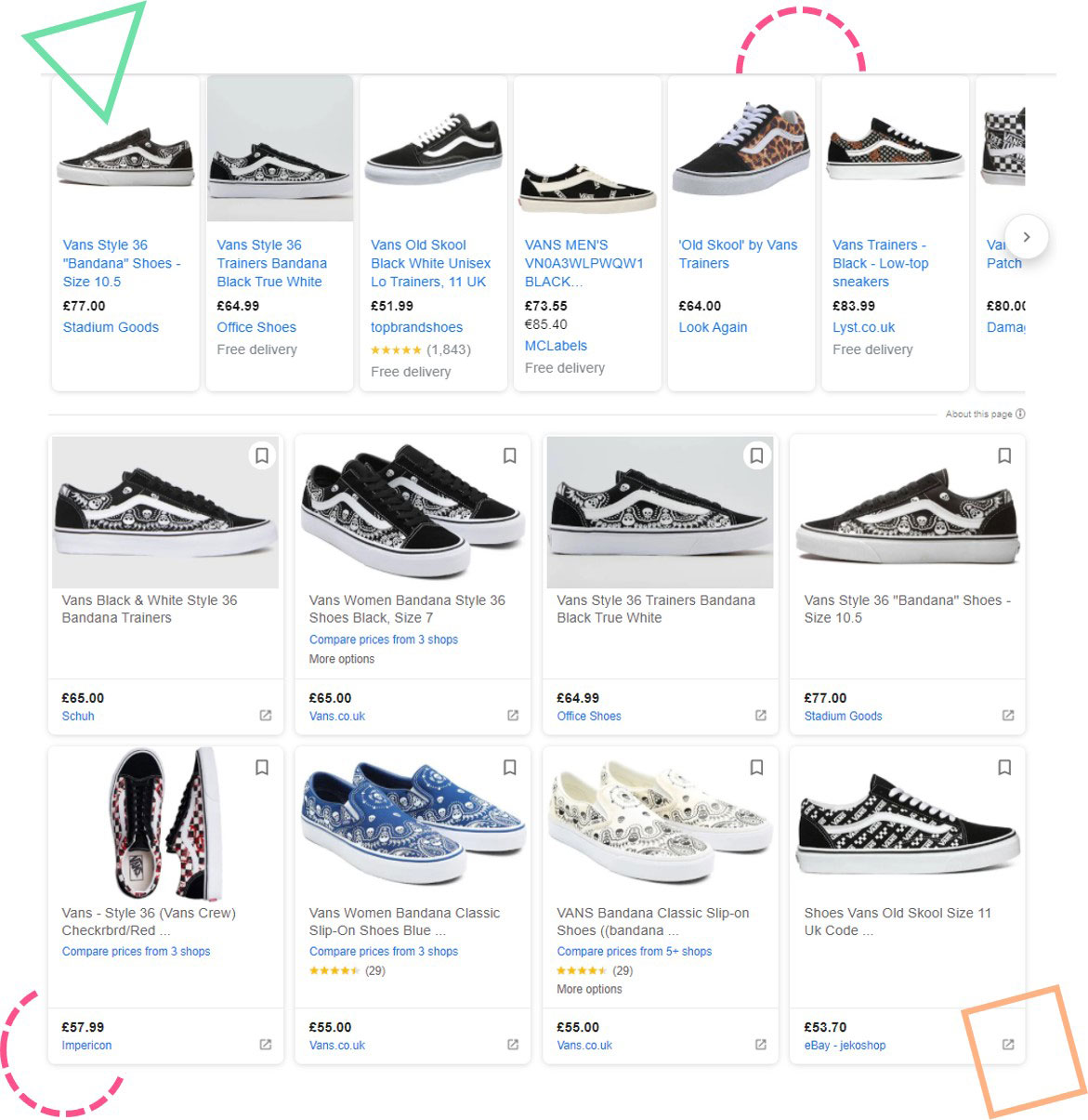
Whilst your bidding strategy is also a factor in the Google Shopping CSS Website, nine out of ten times, Google favour products in the top positions that have Item Group IDs as display a bigger range of options.
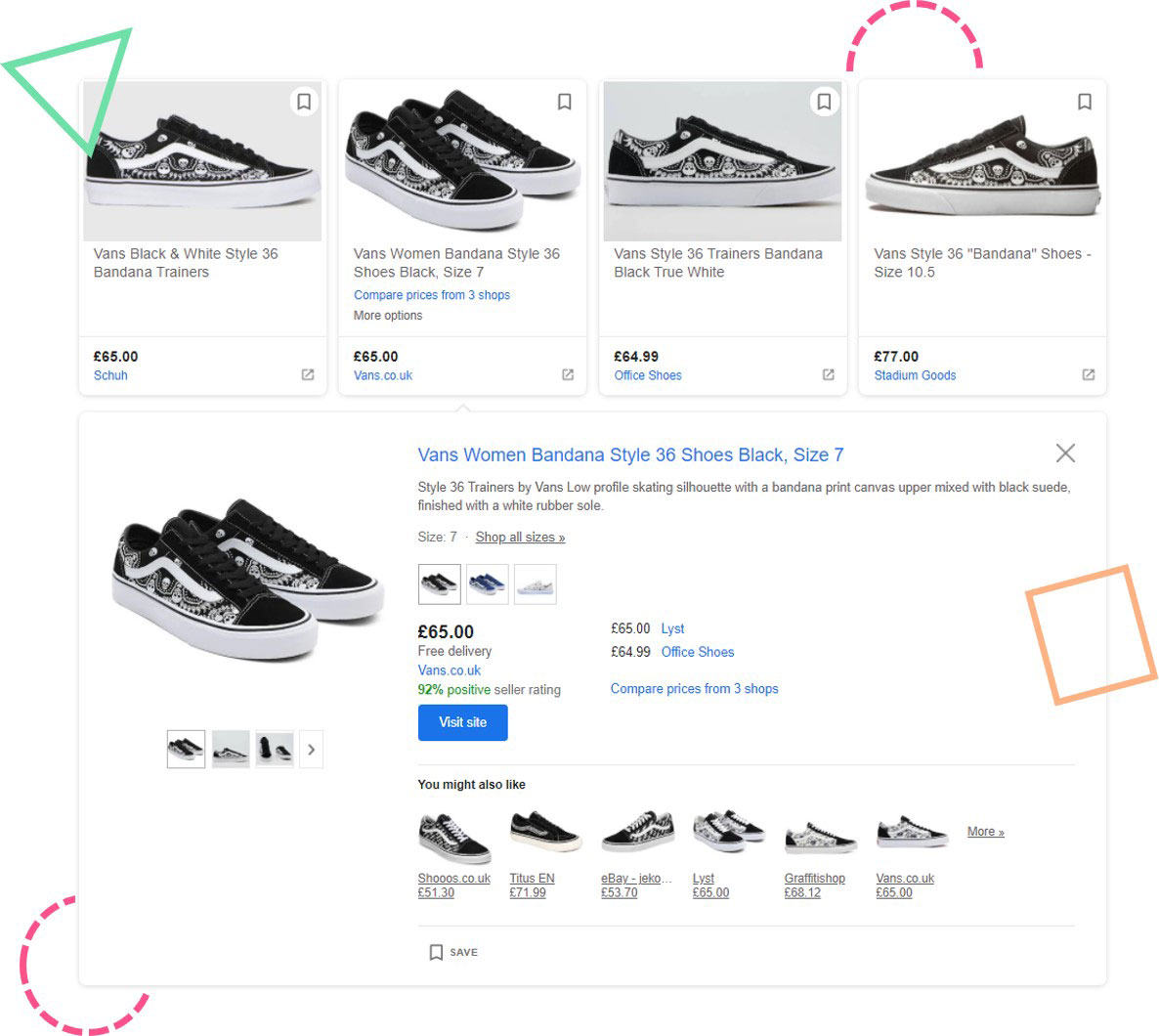
Google also use the GTIN to combine products and compare the live pricing of these products within their results. This also means that they your Product Title and Primary Image within their results, they may use the Product Description from another advertiser and the images from other advertisers to provide more imagery. You have no control over that, although they will favour the Product Image and Product Title with the strongest Click through Rate.
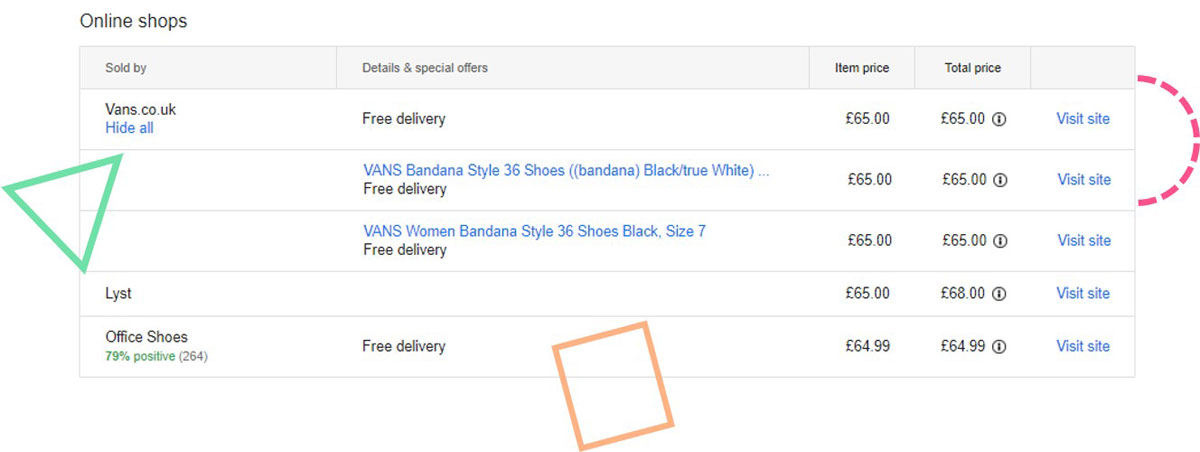
Whilst there is far more to consider within the Google Shopping CSS Website and a smaller portion of traffic, the overall uplift from the improvements you can make can still have a hugely positive impact on your overall Shopping Revenue and Return on Ad Spend.
PRICING
Enterprise Software, Entry Level Prices
Compare our subscription levels and choose your fit.
In-House
Monthly Subscription
- 10 User Logins
- 3 Optimised Output Feeds
- Max 100,000 Products per Feed
- Feed Output Channel: All
- Also Includes:
- Product Edits
- Optimisation Rules
- Performance Rules
- Automated Audits
- Auto Suggestions
- Premium Google CSS
Small
Monthly Subscription
- 20 User Logins
- 10 Optimised Output Feeds
- Max 100,000 Products per Feed
- Feed Output Channel: All
- Also Includes:
- Product Edits
- Optimisation Rules
- Performance Rules
- Automated Audits
- Auto Suggestions
- Premium Google CSS
Medium
Monthly Subscription
- 40 User Logins
- 30 Optimised Output Feeds
- Max 100,000 Products per Feed
- Feed Output Channel: All
- Also Includes:
- Product Edits
- Optimisation Rules
- Performance Rules
- Automated Audits
- Auto Suggestions
- Premium Google CSS
